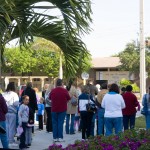 At the second station on our Good Friday Ecumenical prayer Walk, we turned toward Our Lady of Lourdes School. We meditated and prayed:
At the second station on our Good Friday Ecumenical prayer Walk, we turned toward Our Lady of Lourdes School. We meditated and prayed:
Look for me among the unborn infants who are killed for convenience. Look for me among the children who are stolen from their families, sold and trafficked for perverse and inhumane desires. Look for me among the children who are exploited for greed and abandoned in the name of prosperity. Look for me among the children whose special needs keep them confined, silent, and without hope. Look for me among the children, and among the grandparents who are raising them, many with parents in jails and prisons who are unable to care for them and some with parents who are unable to love them. Look for me among the children suffering from AIDS, victims born of victims, all without adequate help and hope. Look for me anywhere a family is in trouble and children are denied a right to education, health care, safety and security.
Seek me there and you shall find me.
Where do we see signs of the Risen Christ alleviating suffering among the children of the world? When I think of the Risen Christ working among children today, I think of Building 418 at St. Gabriel’s Episcopal Church in Titusville, Ferdinand Mafood and Food for the Poor, the Christian Foundation for Children and the Aging, Margaret Trost’s What If Foundation, and Sister Rachel in Somotillo, Nicaragua. Continue reading →




